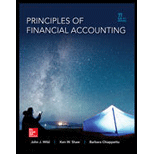
1.
Compute the inventory turnover and days’ sales inventory for each company for the most recent years shown.
1.
Explanation of Solution
Inventory turnover:
This is the ratio which analyzes the number of times inventory is sold during the period. This ratio gauges the efficacy of inventory management. Larger the ratio, more efficient will be the inventory management.
Calculate inventory ratio for Company A’s current year as follows:
Calculate inventory ratio for Company A’s one year prior as follows:
Calculate inventory turnover ratio for Company G’s current year as follows:
Calculate inventory turnover ratio for Company G’s one year prior as follows:
Calculate inventory ratio for Company S’s current year as follows:
Calculate inventory ratio for Company S’s one year prior as follows:
Days’ sales Inventory:
Days’ sales in inventory are used to determine number of days a particular company takes to make sales of the inventory available with them.
Calculate days’ sales inventory for the Company A’s current year as follows:
Calculate days’ sales inventory for the company A’s one year prior as follows:
Calculate days’ sales inventory for the Company G’s current year as follows:
Calculate days’ sales inventory for the Company G’s one year prior as follows:
Calculate days’ sales inventory for the Company S’s current year as follows:
Calculate days’ sales inventory for the Company S’s one year prior as follows:
Note: For the values of Company S and Company G refer the text book (Question 2BTN).
2.
Comment and interpret your findings from parts 1.
2.
Explanation of Solution
Interpret and Comment:
- Company A’s inventory turnover ratio is more efficient than Company G.
- Company A’s days’ sales inventory is fewer than company G.
- However Company S has the lowest inventory turnover ratio and highest days’ sales inventory for both years.
- From the above calculation it is clear that, the inventory turnover ratio of Company A and G is more efficient than Company S. This is because Company S exhibited a slightly decline in the inventory management for the current year from the prior year.
Want to see more full solutions like this?
Chapter 6 Solutions
Principles of Financial Accounting.
- Please provide the solution to this general accounting question with accurate financial calculations.arrow_forwardI need help solving this general accounting question with the proper methodology.arrow_forwardCan you help me solve this general accounting problem using the correct accounting process?arrow_forward
- I need the correct answer to this general accounting problem using the standard accounting approach.arrow_forwardI need assistance with this general accounting question using appropriate principles.arrow_forwardPlease help me solve this general accounting question using the right accounting principles.arrow_forward

 AccountingAccountingISBN:9781337272094Author:WARREN, Carl S., Reeve, James M., Duchac, Jonathan E.Publisher:Cengage Learning,
AccountingAccountingISBN:9781337272094Author:WARREN, Carl S., Reeve, James M., Duchac, Jonathan E.Publisher:Cengage Learning, Accounting Information SystemsAccountingISBN:9781337619202Author:Hall, James A.Publisher:Cengage Learning,
Accounting Information SystemsAccountingISBN:9781337619202Author:Hall, James A.Publisher:Cengage Learning, Horngren's Cost Accounting: A Managerial Emphasis...AccountingISBN:9780134475585Author:Srikant M. Datar, Madhav V. RajanPublisher:PEARSON
Horngren's Cost Accounting: A Managerial Emphasis...AccountingISBN:9780134475585Author:Srikant M. Datar, Madhav V. RajanPublisher:PEARSON Intermediate AccountingAccountingISBN:9781259722660Author:J. David Spiceland, Mark W. Nelson, Wayne M ThomasPublisher:McGraw-Hill Education
Intermediate AccountingAccountingISBN:9781259722660Author:J. David Spiceland, Mark W. Nelson, Wayne M ThomasPublisher:McGraw-Hill Education Financial and Managerial AccountingAccountingISBN:9781259726705Author:John J Wild, Ken W. Shaw, Barbara Chiappetta Fundamental Accounting PrinciplesPublisher:McGraw-Hill Education
Financial and Managerial AccountingAccountingISBN:9781259726705Author:John J Wild, Ken W. Shaw, Barbara Chiappetta Fundamental Accounting PrinciplesPublisher:McGraw-Hill Education





